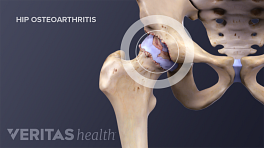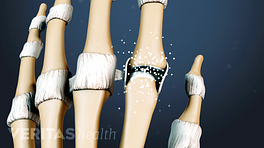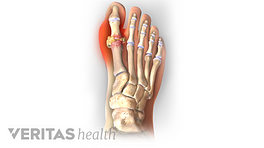Ankle osteoarthritis is a condition in which the ankle's articular cartilage has worn away, causing pain and other symptoms. Knowing the root cause of ankle arthritis can help doctors prescribe an effective treatment.
Approximately 90% of people with ankle arthritis have one of two main risk factors: previous joint trauma or an underlying medical condition. 1 Valderrabano V, Horisberger M, Russell I, Dougall H, Hintermann B. Etiology of ankle osteoarthritis. Clin Orthop Relat Res. 2009;467(7):1800–1806. doi:10.1007/s11999-008-0543-6 The remainder of people usually have other risk factors, such as a family history of osteoarthritis.
In This Article:
- What Is Ankle Osteoarthritis?
- Ankle Osteoarthritis Symptoms
- Ankle Osteoarthritis Causes
- Ankle Osteoarthritis Diagnosis
- Treating Ankle Osteoarthritis
Ankle Arthritis Caused by Injuries
The ankle is especially prone to sprains, fractures, and other injuries, and a joint that has been injured is about 7 times more likely to develop arthritis. 2 American Academy of Orthopaedic Surgeons. OrthoInfo: Arthritis of the Foot and Ankle. Accessed September 24, 2019. Last reviewed March 2015. http://orthoinfo.aaos.org/topic.cfm?topic=A00209 In fact, 70 to 80% of ankle arthritis cases occur in an ankle that has suffered an injury. 1 Valderrabano V, Horisberger M, Russell I, Dougall H, Hintermann B. Etiology of ankle osteoarthritis. Clin Orthop Relat Res. 2009;467(7):1800–1806. doi:10.1007/s11999-008-0543-6 , 3 Hintermann B; Valderrabano V; Knupp M; Horisberger M. [The HINTEGRA ankle: short- and mid-term results]. Orthopade. 2006;35:533-45. German. , 4 Saltzman CL; Salamon ML; Blanchard GM; Huff T; Hayes A; Buckwalter JA; Amendola A. Epidemiology of ankle arthritis: report of a consecutive series of 639 patients from a tertiary orthopaedic center. Iowa Orthop J. 2005;25:44-6.
Ankle arthritis that develops after an injury is sometimes referred to as “post-traumatic arthritis.” The main damage from the trauma may heal and ankle function may return, but the trauma can lead to joint changes that eventually result in ankle osteoarthritis symptoms. (This degeneration can happen even when the traumatic injury is treated correctly.)
Symptoms may appear within two years of the ankle injury or may show up several years, even decades, later.
Ankle Arthritis Caused by Underlying Medical Conditions
About 12% of ankle arthritis cases are linked to an underlying medical condition. 1 Valderrabano V, Horisberger M, Russell I, Dougall H, Hintermann B. Etiology of ankle osteoarthritis. Clin Orthop Relat Res. 2009;467(7):1800–1806. doi:10.1007/s11999-008-0543-6 , 3 Hintermann B; Valderrabano V; Knupp M; Horisberger M. [The HINTEGRA ankle: short- and mid-term results]. Orthopade. 2006;35:533-45. German. Conditions that can increase the risk of developing ankle osteoarthritis include:
- Rheumatoid arthritis and reactive arthritis (these systemic arthritic diseases can cause osteoarthritic damage over time)
- Blood disorders, such as hemophilia, which impairs the blood’s ability to clot, and hemochromatosis, a condition in which the body absorbs too much iron
- Clubfoot or other congenital defects that result in poor ankle joint alignment
- Damage to the bones and cartilage of the ankle joint caused by poor blood circulation, including conditions called avascular talus necrosis and osteochondrosis dissecans
People who have ankle arthritis because of an underlying medical condition tend to experience more pain than people who have post-traumatic ankle arthritis or ankle arthritis with no known cause. 5 Valderrabano V, Horisberger M, Russell I, et al. Etiology of ankle arthritis. Clin Orthop Relat Res 2009;467:1800-6. As cited in Khlopas H, Khlopas A, Samuel LT, Ohliger E, Sultan AA, Chughtai M, Mont MA. Current Concepts in Osteoarthritis of the Ankle: Review. Surg Technol Int. 2019 Jun 25;35. [Epub ahead of print] PubMed PMID: 31237341.
It is important to remember that not everyone who has suffered an ankle trauma or who has an underlying medical condition will get ankle arthritis. These conditions simply increase the likelihood that ankle arthritis will develop.
Ankle Osteoarthritis with No Clear Cause
When ankle osteoarthritis is not caused by a trauma or an underlying medical condition it is called primary ankle arthritis. Primary ankle arthritis accounts for only about 10% of ankle arthritis cases. 1 Valderrabano V, Horisberger M, Russell I, Dougall H, Hintermann B. Etiology of ankle osteoarthritis. Clin Orthop Relat Res. 2009;467(7):1800–1806. doi:10.1007/s11999-008-0543-6 People with primary ankle arthritis tend to be older, experience less pain, and have better range of motion than people with ankle arthritis due to injury or underlying conditions. 1 Valderrabano V, Horisberger M, Russell I, Dougall H, Hintermann B. Etiology of ankle osteoarthritis. Clin Orthop Relat Res. 2009;467(7):1800–1806. doi:10.1007/s11999-008-0543-6 , 4 Saltzman CL; Salamon ML; Blanchard GM; Huff T; Hayes A; Buckwalter JA; Amendola A. Epidemiology of ankle arthritis: report of a consecutive series of 639 patients from a tertiary orthopaedic center. Iowa Orthop J. 2005;25:44-6.
The risk factors for developing primary ankle osteoarthritis include:
Joint stress and mini-traumas
People whose regular activities put strain on their ankles are more likely to develop osteoarthritis. For example, professional ballet dancers who dance “en pointe” and elite soccer players are more prone to ankle arthritis.
6
van Dijk CN, Lim LS, Poortman A, Strübbe EH, Marti RK. Degenerative joint disease in female ballet dancers. Am J Sports Med. 1995 May-Jun;23(3):295-300. PubMed PMID: 7661255.
,
7
Armenis E, Pefanis N, Tsiganos G, Karagounis P, Baltopoulos P. Osteoarthritis of the ankle and foot complex in former Greek soccer players. Foot Ankle Spec. 2011 Dec;4(6):338-43. Epub 2011 Sep 30. PubMed PMID: 21965581.
Advanced age
While most older people do not experience ankle arthritis pain, the chances of developing ankle arthritis increase with age. This is attributed to the wear and tear ankle joints experience over time, which causes the cartilage to thin and become less flexible, making it more prone to osteoarthritis.
In a clinical study of 390 patients, the average age of primary arthritis patients was 65, which was 7 to 8 years older than patients with post-traumatic ankle arthritis or ankle arthritis due to underlying conditions. 1 Valderrabano V, Horisberger M, Russell I, Dougall H, Hintermann B. Etiology of ankle osteoarthritis. Clin Orthop Relat Res. 2009;467(7):1800–1806. doi:10.1007/s11999-008-0543-6
Excess weight / obesity
Ankles bear up to 5 times a person’s body weight during walking,
8
Stauffer RN, Chao EY, Brewster RC. Force and motion analysis of the normal, diseased, and prosthetic ankle joint. Clin Orthop Relat Res. 1977;(127):189-96. PubMed PMID: 912978.
and extra pounds can translate into more joint wear-and-tear and osteoarthritis pain. In addition, people who are obese can have altered body mechanics (the way they walk and stand is sometimes different to compensate for added pounds) possibly making them more prone to ankle osteoarthritis.
9
Runhaar J, Koes BW, Clockaerts S, Bierma-Zeinstra SM. A systematic review on changed biomechanics of lower extremities in obese individuals: a possible role in development of osteoarthritis. Obes Rev. 2011 Dec;12(12):1071-82. doi: 10.1111/j.1467-789X.2011.00916.x. Epub 2011 Aug 3. Review. PubMed PMID: 21812903.
Family history
The likelihood of a person developing osteoarthritis is influenced by genetics, so a person whose parent has osteoarthritis is more likely to develop the disease than another person whose parent did not have osteoarthritis. Experts do not know the exact extent of genetic factors.
Individuals with one or more risk factors are predisposed to osteoarthritis, but they are not guaranteed to get osteoarthritis. It is possible for people who do not have any of the above risk factors to develop osteoarthritis and people with all of the above characteristics to never develop it.
Read more about Osteoarthritis Causes
If ankle pain develops suddenly, it is more likely to be caused by a trauma or another condition such as gout, not by ankle osteoarthritis. If the ankle feels hot or the skin around the joint turns red, then gout, an infection (if it is only one ankle), or rheumatoid arthritis may be the cause.
- 1 Valderrabano V, Horisberger M, Russell I, Dougall H, Hintermann B. Etiology of ankle osteoarthritis. Clin Orthop Relat Res. 2009;467(7):1800–1806. doi:10.1007/s11999-008-0543-6
- 2 American Academy of Orthopaedic Surgeons. OrthoInfo: Arthritis of the Foot and Ankle. Accessed September 24, 2019. Last reviewed March 2015. http://orthoinfo.aaos.org/topic.cfm?topic=A00209
- 3 Hintermann B; Valderrabano V; Knupp M; Horisberger M. [The HINTEGRA ankle: short- and mid-term results]. Orthopade. 2006;35:533-45. German.
- 4 Saltzman CL; Salamon ML; Blanchard GM; Huff T; Hayes A; Buckwalter JA; Amendola A. Epidemiology of ankle arthritis: report of a consecutive series of 639 patients from a tertiary orthopaedic center. Iowa Orthop J. 2005;25:44-6.
- 5 Valderrabano V, Horisberger M, Russell I, et al. Etiology of ankle arthritis. Clin Orthop Relat Res 2009;467:1800-6. As cited in Khlopas H, Khlopas A, Samuel LT, Ohliger E, Sultan AA, Chughtai M, Mont MA. Current Concepts in Osteoarthritis of the Ankle: Review. Surg Technol Int. 2019 Jun 25;35. [Epub ahead of print] PubMed PMID: 31237341.
- 6 van Dijk CN, Lim LS, Poortman A, Strübbe EH, Marti RK. Degenerative joint disease in female ballet dancers. Am J Sports Med. 1995 May-Jun;23(3):295-300. PubMed PMID: 7661255.
- 7 Armenis E, Pefanis N, Tsiganos G, Karagounis P, Baltopoulos P. Osteoarthritis of the ankle and foot complex in former Greek soccer players. Foot Ankle Spec. 2011 Dec;4(6):338-43. Epub 2011 Sep 30. PubMed PMID: 21965581.
- 8 Stauffer RN, Chao EY, Brewster RC. Force and motion analysis of the normal, diseased, and prosthetic ankle joint. Clin Orthop Relat Res. 1977;(127):189-96. PubMed PMID: 912978.
- 9 Runhaar J, Koes BW, Clockaerts S, Bierma-Zeinstra SM. A systematic review on changed biomechanics of lower extremities in obese individuals: a possible role in development of osteoarthritis. Obes Rev. 2011 Dec;12(12):1071-82. doi: 10.1111/j.1467-789X.2011.00916.x. Epub 2011 Aug 3. Review. PubMed PMID: 21812903.










